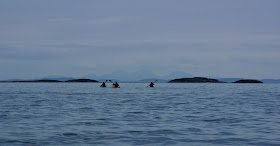On the evening before the venture I travelled across from home and stayed at the Glenuig Inn. Whilst enjoying a pint after dinner I got talking to Andy, who was travelling in a classic VW camper van and kayaking at various locations. We agreed to paddle together the following day after I'd seen the team away from their starting point at Ardtoe.
We planned to paddle from Glenuig across the Sound of Arisaig - Andy was tempted by descriptions of stunning beaches on a wild coast, and I was very glad when the morning turned out sunny and clear; perfect to see this coast at its best! Once out into the Sound of Arisaig, the familiar outline of Eigg with Rum beyond provide a scenic backdrop to the crossing.
We reached the north side of the Sound and paddled along the coast, soon arriving at one of the best of the small beaches. I planned to camp here that evening in order to meet the team as they headed in towards their own camp and so put up the tent......
....while we dawdled on the beach in baking heat.
After lunch we continued west along the rugged coastline towards what I assured Andy would be a superb beach.
It's not all sandy beaches here though; one particular pebble strand which appears uniformly grey from a distance has a variety of richly coloured pebbles at closer inspection. It's a place I can (and have) spent hours photographing pebbles as the tide ebbs back leaving them wet and shining.
But, white sand beaches and aquamarine water had been promised, so after a brief stop, on we went....
...to arrive at a beach which will be quite familiar to readers of this blog. It's so attractive and relatively easy of access that it gets plenty of visitors and is heavily used for camping by walkers and paddlers, including some large commercial guided sea kayaking groups. To do a small bit in reducing impact, neither Douglas or I choose to camp here any more.
It has to be said though, it's a stunning location with a view to match. The coloured object above the high water mark proved to be a substantial piece of trawl net. I tried to cut some bits away to remove them but it was way too big to make any kind of difference.
On a sunny day, the water close to the shore at this beach is remarkable, deep indigo blue through shades of aquamarine and turqoise to a quality very well described by my friend Duncan as "so clear, it's hardly there"
I think the colour of Andy's North Shore Atlantic kayak matches the location rather well!
We spent some time on the beach chatting with other folk enjoying the warm sunshine and gorgeous views before getting back into the boats to paddle back along the shore. Andy would head back across the Sound of Arisag to Glenuig while I would meet the team of paddlers near their camp before heading to my own camp for the evening.
It was really good to meet Andy and to share some time on the water with him; and it's always a special pleasure to visit familiar places with someone visiting for the first time, to see the place afresh. I watched until Andy was a speck in the distance heading over towards Glenuig, then landed and climbed to a vantage point where I could watch for four young adventurers who were also exploring this area for the first time.



















































